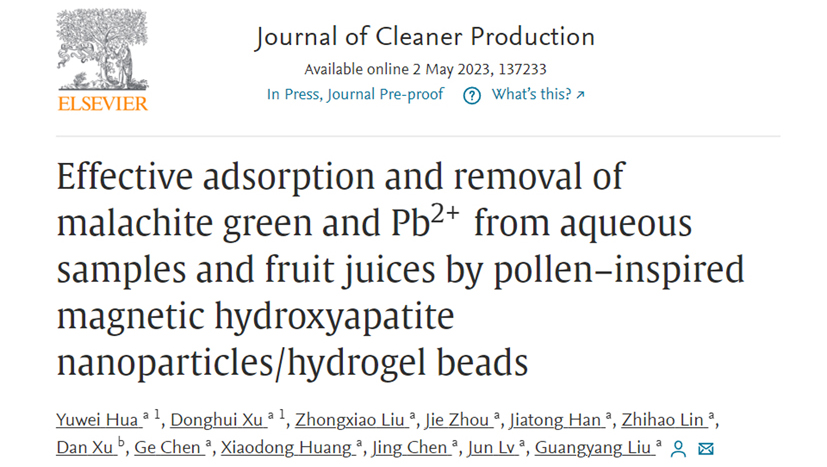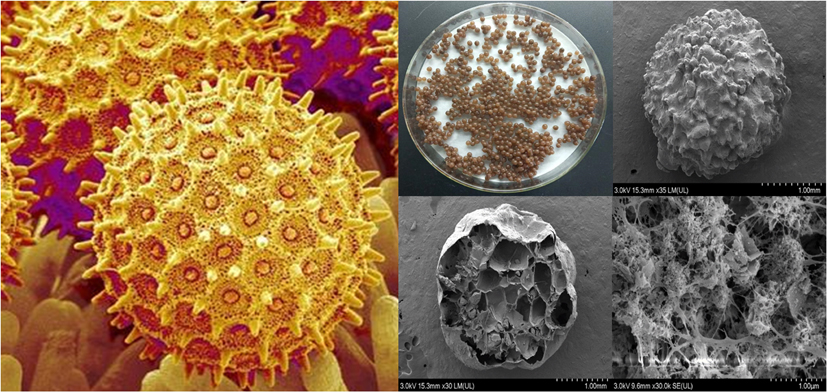Recently, the Quality and Safety Research Group of the Institute of the Vegetables and Flowers, Chinese Academy of Agricultural Sciences, prepared a new biomimetic hydrogel composite microsphere, analyzed its mechanism of binary chemical pollutant recognition, and successfully used it in environmental samples and mixed pollutants in food. The related research results were published in Journal of Cleaner Production as "Effective adsorption and removal of malachite green and Pb2+ from aqueous samples and fruit juices by pollen–inspired magnetic hydroxyapatite nanoparticles/hydrogel beads" (IF=11.072 Q1).

Hydrogel is a three-dimensional network polymer adsorbent material containing hydrophilic groups. Traditional hydrogels have disadvantages such as poor chemical stability, low mechanical strength and repeatable utilization. Biomimetic functional hybridization of hydrogels using nanocomposites is an effective approach to solve the above problems. Pollen has a natural hollow hierarchical porous structure, and the outer wall of the pore groove has fine spines and granular carvings. These characteristics endow pollen particles with high adhesion and adsorption properties. Hydroxyapatite (HAP) is the main component of animal bones, and it often presents an ordered porous self-assembled structure. By doping and modifying hydrogel with HAP to simulate the hollow hierarchical porous structure and near-spherical morphology of pollen, it can not only enhance the stability and mechanical toughness of the hydrogel can also significantly improve its pollutant recognition and adsorption performance.
Inspired by the spherical structure of the petunia pollen particles, this study synthesized magnetic HAP-functionalized sodium alginate hydrogel spheres by using the secondary cross-linking method of calcium ions and iron ions. The study found that the biomimetic hydrogel composite microspheres have high selective separation, high chemical stability, strong reusability, and excellent adsorption and removal performance for malachite green (MG) and lead ions (Pb2+). Static, dynamic, and thermodynamic adsorption models were used to deeply explore the adsorption and mass transfer process of pollutants on composite materials, revealing that static adsorption conforms to the Langmuir model, mainly dominated by monolayer adsorption; MG dynamic adsorption conforms to the pseudo-first-order model, and Pb2+ conforms to the According to the pseudo-second-order model, thermodynamic adsorption is a spontaneous endothermic process; under the optimal experimental conditions, the maximum adsorption amounts of MG and Pb2+ are 208.06 and 475.50 mg/g, respectively. By correlating SEM, XRD, FT-IR, XPS and other nano-characterization results, the mechanism of action of temperature-dependent chemisorption to dominate the recognition and significantly increase the adsorption and mass transfer rates was further analyzed, and the interaction mechanism of multiple chemical bonds such as electrostatic adsorption, ion exchange and metal complexation to synergistically enhance the recognition of pollutant molecules was revealed. Finally, the composite microspheres were successfully used for the adsorption and removal of binary mixed pollutants in agricultural irrigation water and fruit juice samples. This study provides new research ideas for the design, preparation and modification of biomimetic hydrogels, and provides a new research model for in-depth understanding of the recognition and interaction between porous adsorption materials and chemical pollutants, and the development of new pollution control and removal technologies.

Fig.1 The preparation process and adsorption recognition principle of hydrogel composite microspheres

Figure 2 Microstructure of petunia pollen particles and hydrogel composite microspheres
The Institute of Vegetables and Flowers of the Chinese Academy of Agricultural Sciences is the first unit to complete the paper. Researcher Yuwei Hua, graduate students, and the Dr. Donghui Xu of the Institute of Vegetables and Flowers, are the co-first authors, and Dr. Guangyang Liu is the corresponding author. The research was supported by National Key Research and Development Program of China (2022YFF0606800), China Agriculture Research System of MOF and MARA (CARS-23-E03), and the Risk Assessment on Vegetable Products(GJFP20210201)
Original link: https://www.sciencedirect.com/science/article/pii/S0959652623013914